Social Impacts of Place-Making in Urban Informal Settlements: A Case Study of Indonesian Kampungs †
Abstract
:1. Introduction
2. Place-Making as Process
Classification of ‘Regular’ and ‘Temporal’ Place-Making
3. Area of Study
3.1. Introduction of Indonesian Urban Kampungs
3.2. Informal Characteristics of Kampungs
3.3. Physical Characteristic
3.4. Economic Characteristic
3.5. Social Characteristic
3.6. Spatial Characteristic
3.7. Study Site
3.8. Kampung Dago Pojok
3.9. Kampung Bustaman
4. Methodology
4.1. Participants of the Household Survey
4.2. Measures
4.3. Measurement of Independent Variables
4.4. Local Capacity
4.5. Network
4.6. Regular and Temporal Place-Making
4.7. Socio-Economic Status
4.8. Measurement of Dependent Variables
4.9. Local Empowerment
4.10. Social Connection
4.11. Quality of Life
4.12. Local Identity and Pride
5. Data Analysis
5.1. Multiple Regression Analysis
5.2. Independent Variables
5.3. Dependent Variables
5.4. Control Variables
6. Findings
6.1. Sample Characteristics
6.2. Place-Making Arrangements in Two Kampung Cases
6.3. Multiple Linear Regression
7. Discussion
8. Conclusions
Author Contributions
Funding
Acknowledgments
Conflicts of Interest
Appendix A
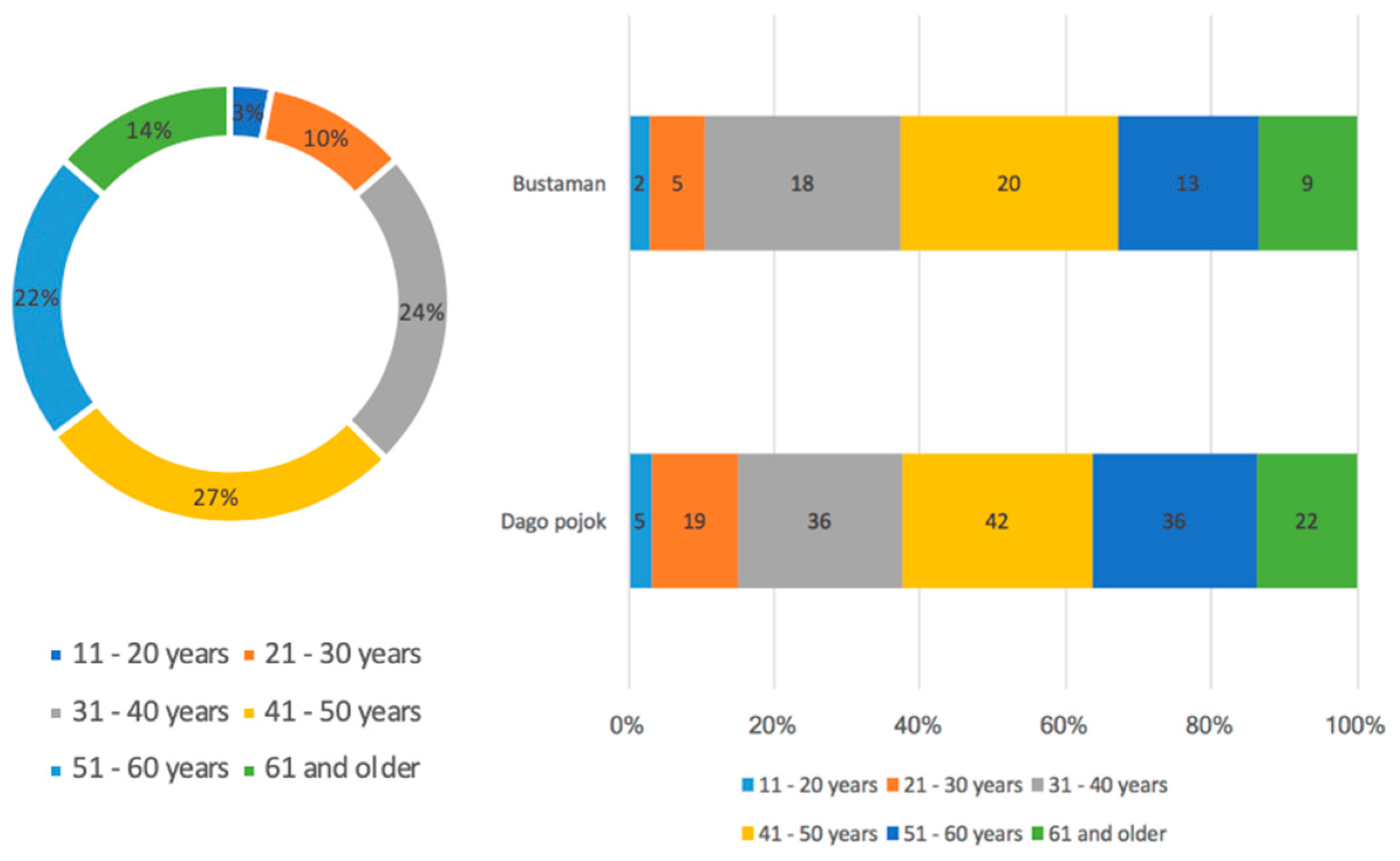
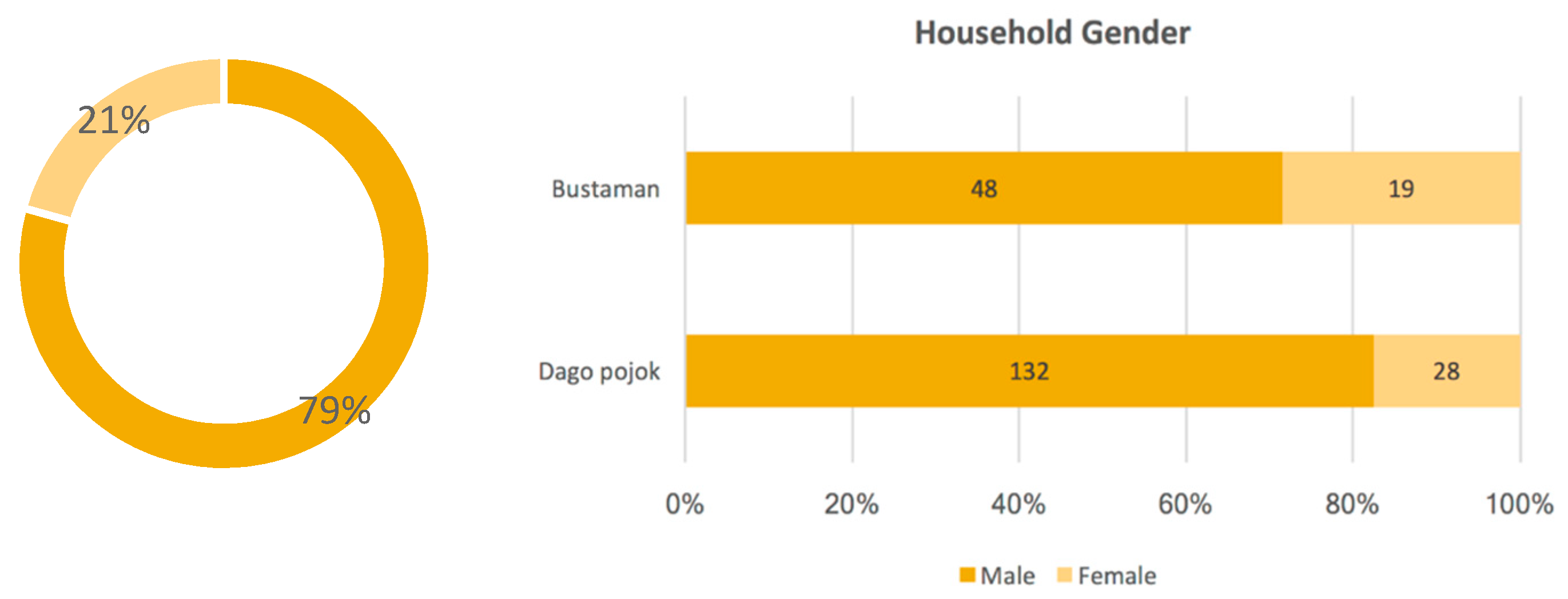
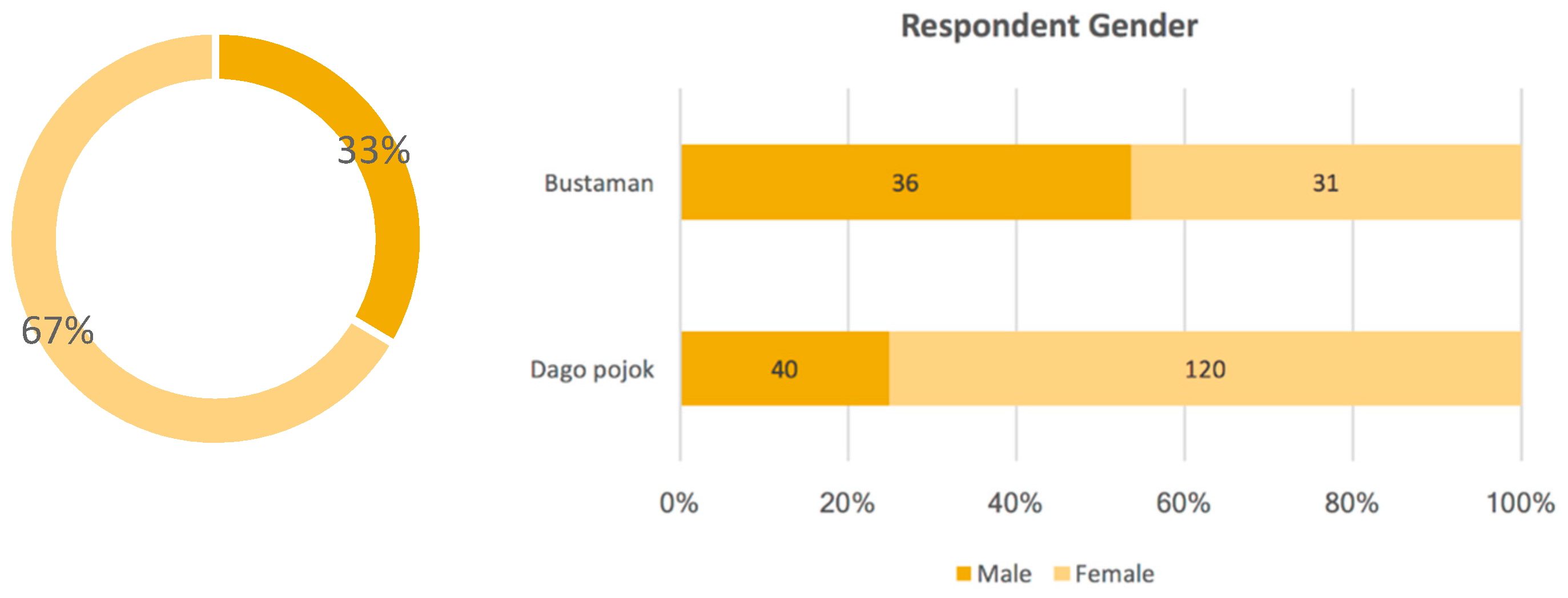

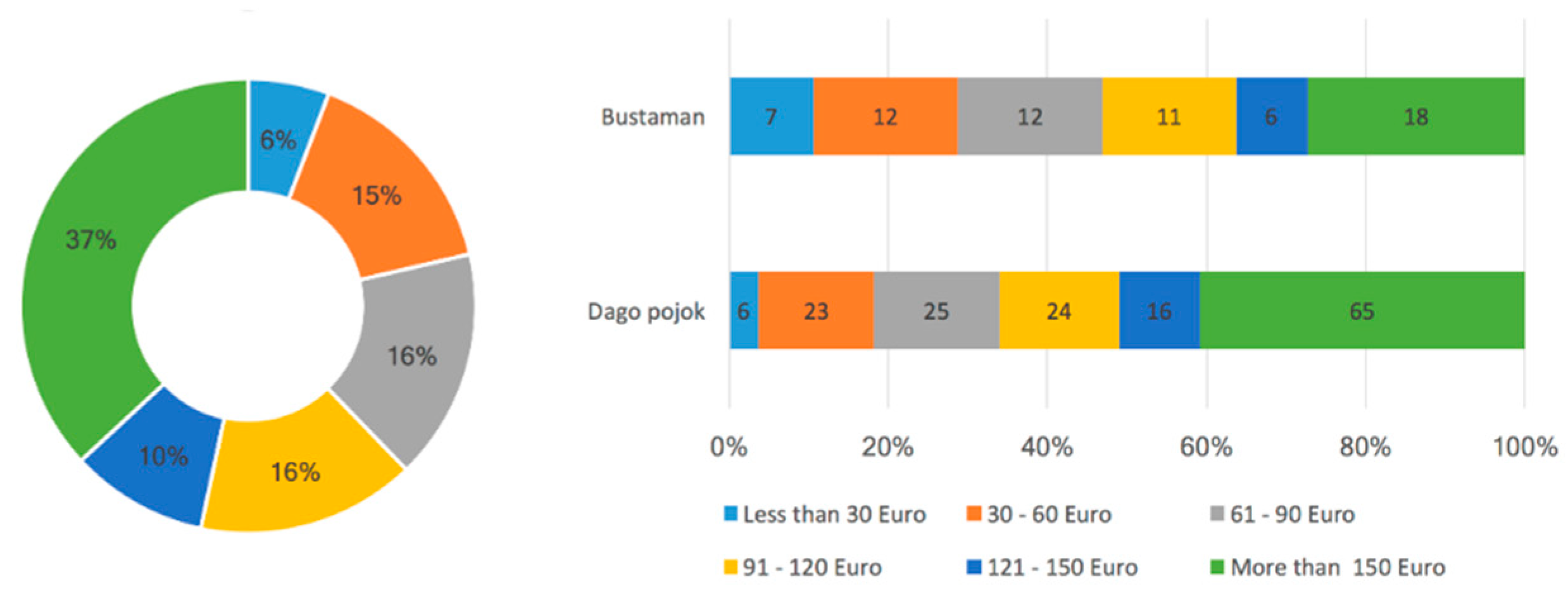
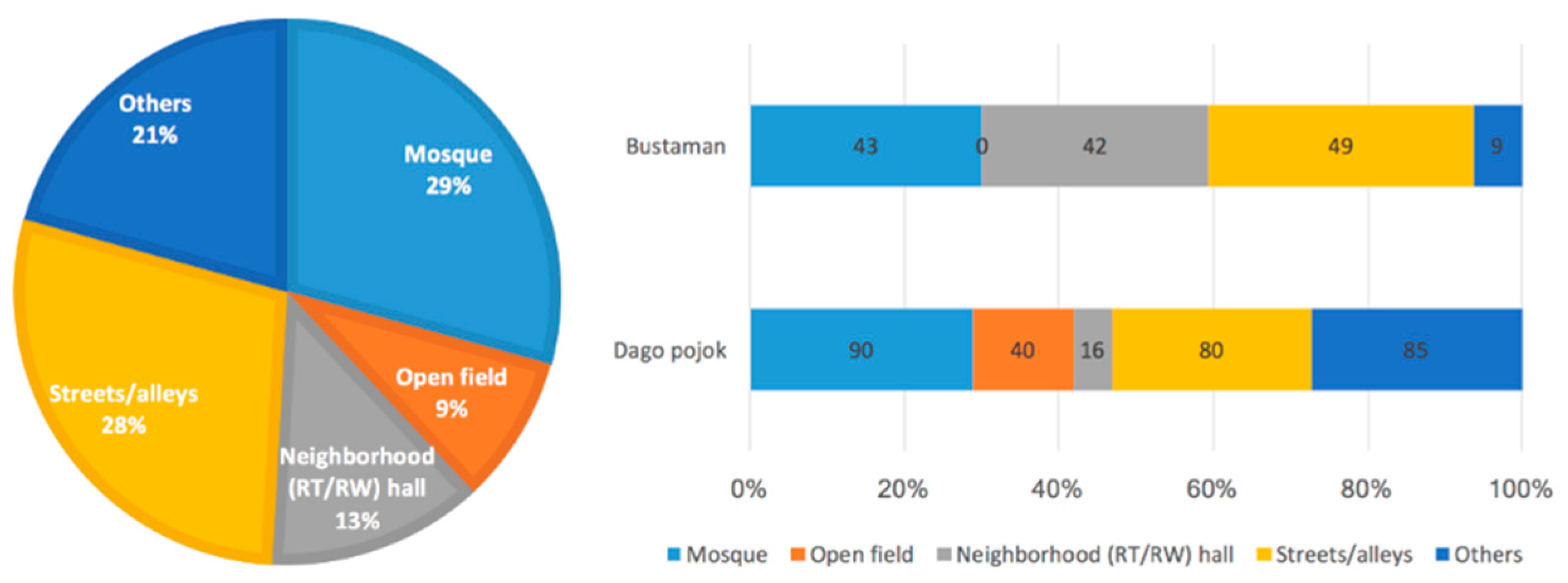


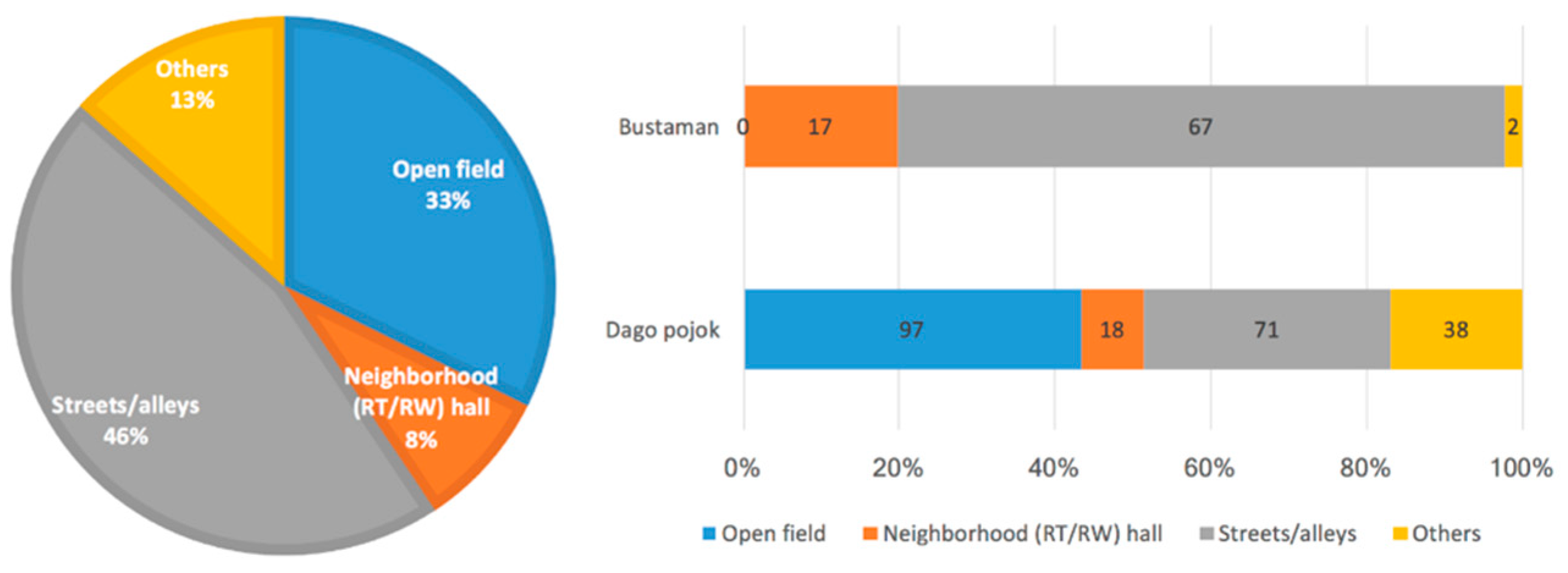

| Type of Occupation | Dago Pojok | Bustaman |
|---|---|---|
| Day labor | 33 | 13 |
| Construction labor | 15 | 2 |
| Servant/maid | 2 | 0 |
| Petty business | 21 | 22 |
| Business owner using hired labor | 1 | 3 |
| Self-employed in business/service provision | 16 | 13 |
| Regular employee in government or NGO | 23 | 2 |
| Regular employee in fixed business establishment | 24 | 5 |
| Allowance | 19 | 2 |
| Others | 6 | 5 |
References
- Alaimo, Katherine, Thomas M. Reischl, and Julie Ober Allen. 2010. Community gardening, neighborhood meetings, and social capital. Journal of Community Psychology 38: 497–514. [Google Scholar] [CrossRef]
- Alzahrani, A., Katharina Borsi, and D. Jarman. 2016. Place-making and its implications for social value: A comparison study of two urban squares in London. Urban Regeneration & Sustainability 12: 392. [Google Scholar]
- Andres, Lauren. 2013. Differential Spaces, Power Hierarchy and Collaborative Planning: A Critique of the Role of Temporary Uses in Shaping and Making Places. Urban Studies 50: 759–75. [Google Scholar] [CrossRef] [Green Version]
- Balassiano, Katia, and Marta Maria Maldonado. 2015. Placemaking in rural new gateway communities. Community Development Journal 50: 644–60. [Google Scholar] [CrossRef]
- Bendt, Pim, Stephan Barthel, and Johan Colding. 2013. Civic greening and environmental learning in public-access community gardens in Berlin. Landscape and Urban Planning 109: 18–30. [Google Scholar] [CrossRef]
- Bowen, John R. 1986. On the Political Construction of Tradition: Gotong Royong in Indonesia. The Journal of Asian Studies 45: 545–61. [Google Scholar] [CrossRef]
- Brisson, Daniel S., and Charles L. Usher. 2005. Bonding social capital in low-income neighborhoods. Family Relations: Interdisciplinary Journal of Applied Family Studies 54: 644–53. [Google Scholar] [CrossRef]
- Brunnberg, Liselott, and Alberto Frigo. 2012. Placemaking in the 21st-century city: Introducing the funfair metaphor for mobile media in the future urban space. Digital Creativity 23: 113–25. [Google Scholar] [CrossRef]
- Chan, Selina Ching. 2011. Cultural governance and place-making in Taiwan and China. China Quarterly 206: 372–90. [Google Scholar] [CrossRef]
- Cilliers, E., W. Timmermans, F. Van den Goorbergh, and J. Slijkhuis. 2015. The Story Behind the Place: Creating Urban Spaces That Enhance Quality of Life. Applied Research in Quality of Life 4: 589–98. [Google Scholar] [CrossRef]
- Coghlan, Alexandra, Bev Sparks, Wei Liu, and Mike Winlaw. 2017. Reconnecting with place through events: Collaborating with precinct managers in the placemaking agenda. International Journal of Event and Festival Management 8: 66–83. [Google Scholar] [CrossRef] [Green Version]
- Delconte, John, Carol S. Kline, and Carmine Scavo. 2016. The impacts of local arts agencies on community placemaking and heritage tourism. Journal of Heritage Tourism 11: 324–35. [Google Scholar] [CrossRef]
- Douglas, Gordon C. C. 2016. The formalities of informal improvement: Technical and scholarly knowledge at work in do-it-yourself urban design. Journal of Urbanism: International Research on Placemaking and Urban Sustainability 9: 117–34. [Google Scholar] [CrossRef]
- Dovey, Kim, and Ross King. 2012. Informal Urbanism and the Taste for Slums. Tourism Geographies 14: 275–93. [Google Scholar] [CrossRef]
- Drinkwater, Bahar Durmaz, and Stephen Platt. 2016. Urban development process and creative clustering: The film industry in Soho and Beyoğlu. Urban Design International 21: 151–74. [Google Scholar] [CrossRef]
- Dukanovic, Zoran, and Zivkovic Jelena. 2015. Public Art & Public Space Programme: Learning, But Doing! Annales-Anali Za Istrske in Mediteranske Studije-Series Historia et Sociologia 25: 49–64. [Google Scholar]
- Elwood, Sarah, Victoria Lawson, and Samuel Nowak. 2015. Middle-Class Poverty Politics: Making Place, Making People. Annals of the Association of American Geographers 105: 123–43. [Google Scholar] [CrossRef]
- Friedmann, John. 2010. Place and place-making in cities: A global perspective. Planning Theory & Practice 11: 149–65. [Google Scholar]
- Houghton, Kirralie, Foth Marcus, and Miller Evonne. 2015. Urban Acupuncture: Hybrid Social and Technological Practices for Hyperlocal Placemaking. Journal of Urban Technology 22: 3–19. [Google Scholar] [CrossRef]
- Hunter, James. 2012. Place matters: But does local leadership? Public Money and Management 32: 95–102. [Google Scholar] [CrossRef] [Green Version]
- Jaeger, Kari, and Reidar J. Mykletun. 2013. Festivals, identities and belonging. Event Management 17: 213–26. [Google Scholar] [CrossRef]
- Jamal, Tazim B., and Donald Getz. 1995. Collaboration theory and community tourism planning. Annals of Tourism Research 22: 186–204. [Google Scholar] [CrossRef]
- Kern, Leslie. 2015. Rhythms of gentrification: Eventfulness and slow violence in a happening neighborhood. Cultural Geographies 23: 441–57. [Google Scholar] [CrossRef]
- Larson, C., and J. Guenther. 2012. Parklets planning with place-making in mind rationale and strategy for municipal planners. Plan Canada 52: 43–47. [Google Scholar]
- Lazarević, E. V., A. B. Koružnjak, and M. Devetaković. 2016. Culture design-led regeneration as a tool used to regenerate deprived areas. Belgrade—The Savamala quarter; reflections on an unplanned cultural zone. Energy and Buildings 115: 3–10. [Google Scholar] [CrossRef]
- Lew, Alan A. 2017. Tourism planning and place making: Place-making or placemaking? Tourism Geographies 19: 448–66. [Google Scholar] [CrossRef]
- Lombard, Melanie. 2014. Constructing ordinary places: Place-making in urban informal settlements in Mexico. Progress in Planning 94: 1–53. [Google Scholar] [CrossRef]
- Main, Kelly, and Gerardo Francisco Sandoval. 2015. Placemaking in a translocal receiving community: The relevance of place to identity and agency. Urban Studies 52: 71–86. [Google Scholar] [CrossRef]
- Marshall, N., and K. Bishop. 2015. Is there any correlation between placemaking and place attachment? A challenge for interdisciplinary research. The International Journal of Interdisciplinary Social and Community Studies 9: 1–10. [Google Scholar] [CrossRef]
- Ohmer, Mary, and Elizabeth Beck. 2006. Citizen participation in neighborhood organizations in poor communities and its relationship to neighborhood and organizational collective efficacy. The Journal of Sociology and Social Welfare 33: 179–202. [Google Scholar]
- Peng, Li-Pei. 2013. Effects of anti-dam campaigns on institutional capacity: A case study of Meinung from Taiwan. Paddy and Water Environment 11: 353–67. [Google Scholar] [CrossRef]
- Pollock, Venda Louise, and Ronan Paddison. 2014. On place-making, participation and public art: The Gorbals, Glasgow. Journal of Urbanism 7: 85–105. [Google Scholar] [CrossRef]
- Quayle, Moura, and Tilo C. Driessen van der Lieck. 1997. Growing community: A case for hybrid landscapes. Landscape and Urban Planning 39: 99–107. [Google Scholar] [CrossRef]
- Reis, H. T., K. M. Sheldon, S. L. Gable, J. Roscoe, and R. M. Ryan. 2000. Daily Well-Being: The Role of Autonomy, Competence, and Relatedness. Personality and Social Psychology Bulletin 26: 419–35. [Google Scholar] [CrossRef]
- Rota, Francesca S., and Carlo Salone. 2014. Place-making processes in unconventional cultural practices. The case of Turin’s contemporary art festival Paratissima. Cities 40: 90–98. [Google Scholar] [CrossRef]
- Sampson, R. 2004. Neighborhood and community: Collective efficacy and community safety. New Economy 11: 106–13. [Google Scholar] [CrossRef]
- Sandoval, Gerardo Francisco, and Marta Maria Maldonado. 2012. Latino Urbanism revisited: Placemaking in new gateways and the urban-rural interface. Journal of Urbanism: International Research on Placemaking and Urban Sustainability 5: 193–218. [Google Scholar] [CrossRef]
- de Carteret, P. 2008. Diverse pleasures: Informal learning in community. Australian Journal of Adult Learning 48: 502–21. [Google Scholar]
- Arnauld de Sartre, Xavier, Vincent Berdoulay, and Raquel Da Silva Lopes. 2012. Eco-Frontier and Place-Making: The Unexpected Transformation of a Sustainable Settlement Project in the Amazon. Geopolitics 17: 578–606. [Google Scholar] [CrossRef]
- Semenza, Jan C., Tanya L. March, and Brian D. Bontempo. 2007. Community-initiated urban development: An ecological intervention. Journal of Urban Health: Bulletin of the New York Academy of Medicine 84: 8–20. [Google Scholar] [CrossRef] [Green Version]
- Semenza, Jan C., and Tanya L. March. 2009. An urban community-based intervention to advance social interactions. Environment and Behavior 41: 22–42. [Google Scholar] [CrossRef]
- Sutandyo-Buchholz, A. 2013. Collective Activity as a Traditional Knowledge Behind the Physical Design. Case of Urban Kampungs in Indonesia. Planum The Journal of Urbanism 26: 1–13. [Google Scholar]
- Till, Karen E., and Rachel McArdle. 2015. The Improvisional City: Valuing urbanity beyond the chimera of permanence. Irish Geography 48: 37–68. [Google Scholar]
- Wakefield, S., F. Yeudall, C. Taron, J. Reynolds, and A. Skinner. 2007. Growing urban health: Community gardening in South-East Toronto. Health Promotion International 22: 92–101. [Google Scholar] [CrossRef]
- Woronkowicz, Joanna. 2015. Art-Making or Place-Making? The Relationship between Open-Air Performance Venues and Neighborhood Change. Journal of Planning Education and Research 36: 49–59. [Google Scholar] [CrossRef]
- Arefi, Mahyar. 2014. Deconstructing Placemaking: Needs, Opportunities, and Assets. Oxon: Routledge, pp. 50–77. [Google Scholar]
- Cohen, M., K. Maund, T. Gajendran, J. Lloyd, and C. Smith. 2018. Communities of Practice Collaborative Project: Valuing Creative Placemaking: Development of a Toolkit for Public and Private Stakeholders. Sydney: Landcom. [Google Scholar]
- Cresswell, T. 2004. Place: A Short Introduction. Hoboken: Wiley-Blackwell, vol. 1. [Google Scholar]
- Hordijk, M., L. Sara, C. Sutherland, and D. Scott. 2015. Participatory Instruments and Practices in Urban Governance. In Geographies of Urban Governance. Edited by J. Gupta, K. Pfeffer, H. Verrest and M. Ros-Tonen. Amsterdam: Springer, pp. 127–47. [Google Scholar]
- Lefebvre, H. 1991. The Production of Space. Hoboken: Blackwell. [Google Scholar]
- Ponzini, Davide, and Pier Carlo Palermo. 2014. Placemaking and Urban Development: New Challenges for Contemporary Planning and Design. Oxon: Routledge. [Google Scholar]
- Rahmi, Dwita Hadi, Bambang Hari Wibisono, and Bakti Setiawan. 2001. Rukun and gotong royong: Managing Public Places in an Indonesian kampung. In Public places in Asia Pacific Cities. Edited by Pu Miao. Dordrecht: Springer, pp. 119–34. [Google Scholar]
- Rao, Vijayendra. 2001. Poverty and Public Celebrations in Rural India. Available online: http://documents.worldbank.org/curated/en/433791468773973485/Poverty-and-public-celebrations-in-rural-India (accessed on 19 April 2019).
- Silberberg, S., K. Lorah, R. Disbrow, and A. Muessig. 2013. Places in the Making: How Placemaking Builds Places and Communities. Cambridge: Massachusetts Institute of Technology. [Google Scholar]
- Simarmata, Hendricus Andy. 2018. Phenomenology in Adaptation Planning: An Empirical Study of Flood-Affected People in Kampung Muara Baru Jakarta. Singapore: Springer. [Google Scholar]
- Stewart, A. 2010. Place-Making and Communities: A Review of Concepts, Indicators, Policy, and Practice. London: The Research Agency of the Forestry Commision. [Google Scholar]
- Zelinka, Al, and Susan Jackson Harden. 2005. Placemaking on a Budget: Improving Small Towns, Neighborhoods, and Downtowns without Spending a lot of Money. Michigan: American Planning Association. [Google Scholar]
- Sihombing, Antony. 2004. The Transformation of Kampung Kota: Symbiosis between Kampung and Kota. Jakarta, Indonesia: University of Indonesia, Unpublished work. [Google Scholar]
- Qu, Lei, and Machiel Dorst. 2014. Environment and behaviour interaction in two urban villages of Shenzen. Paper presented at 11th International Symposium on Environment-Behavior Research, China University of Technology, Taipei, Taiwan, 22 August 2015. [Google Scholar]
- Sudarwanto, Budi, Gagoek Hardiman, Atiek Suprapti, and Agung B. Sarjono. 2017. The Uniqueness and Complexity of Kampung City Bustaman Semarang Indonesia. Paper presented at International Conference on Sustainability in Architectural Design and Urbanism, Semarang, Indonesia, 1 December 2017. [Google Scholar]
- Hutama, Irsyad Adhi Waskita. 2016. Exploring the Sense of Place of an Urban Kampung. Through the Daily Activities, Configuration of Space and Dweller’s Perception: Case Study of Kampung Code, Yogyakarta. Master’s dissertation, Gadjah Mada University, Yogyakarta, Indonesia. [Google Scholar]
- Indraswari, Indraswari. 2006. Women and Warung in an Urban Kampung. Ph.D. dissertation, Bandung Institute of Technology, Bandung, Indonesia. [Google Scholar]
- Iwińska, K. 2017. Towards Better Participatory Planning: Guide to Place-Making. Master’s dissertation, Utrecht University, Utrecht, The Netherlands. [Google Scholar]
- Putra, B. D. 2018. Placemaking Dynamism of Green Space Production in Urban Kampung Setting: A Case Study in Jakarta, Indonesia. Ph.D. dissertation, RMIT University, Melbourne, Australia. [Google Scholar]
- Setiawan, Teguh. 2010. Role of Public Art in Urban Environment: A Case Study of Mural Art in Yogyakarta City. Master’s dissertation, Gadjah Mada University, Yogyakarta, Indonesia. [Google Scholar]
- Susetyo, N. A. 2015. Linking Urban Poor Participation with Comprehensive Tourism Governance. Master’s dissertation, International Institute of Social Studies Erasmus University, Hague, The Netherlands. [Google Scholar]
- PPS. 2018. What Makes a Successful Place. Available online: https://www.pps.org/article/grplacefeat (accessed on 6 May 2019).
- UGD. 2015. Tugu Bustaman: Dari Kampung Membangun Budaya Berkota. Available online: http://www.ugdsemarang.org (accessed on 2 February 2016).
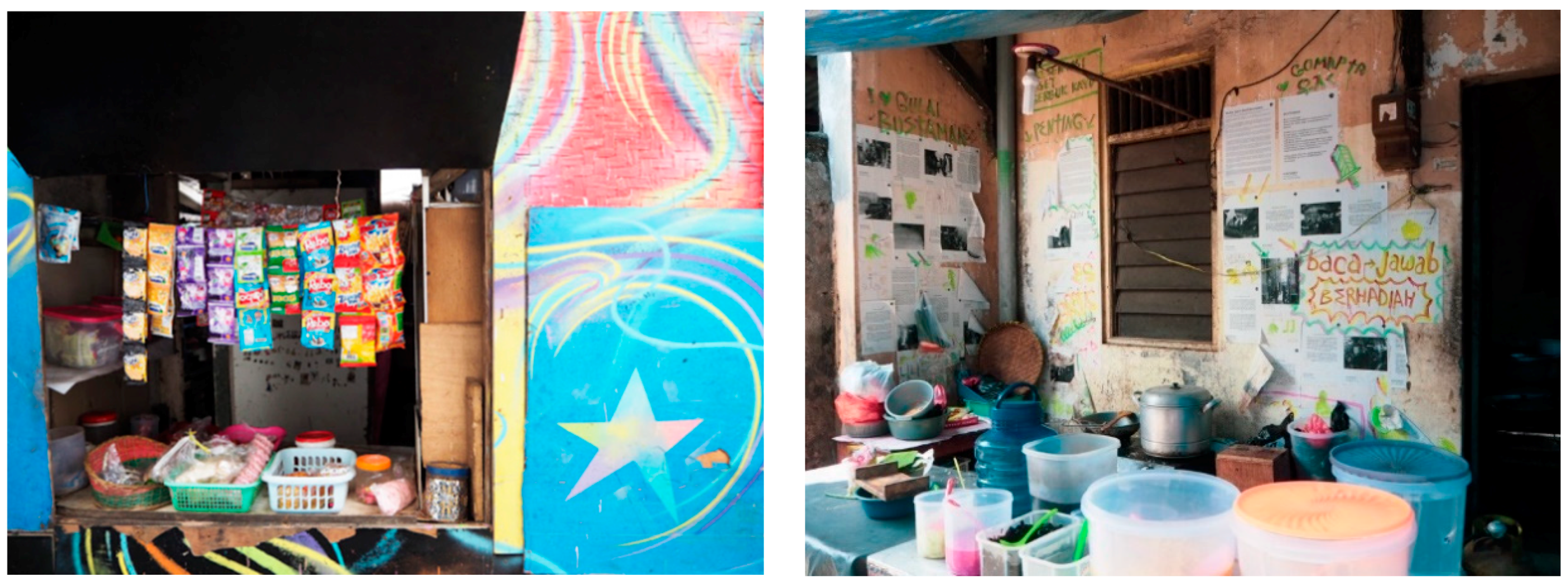
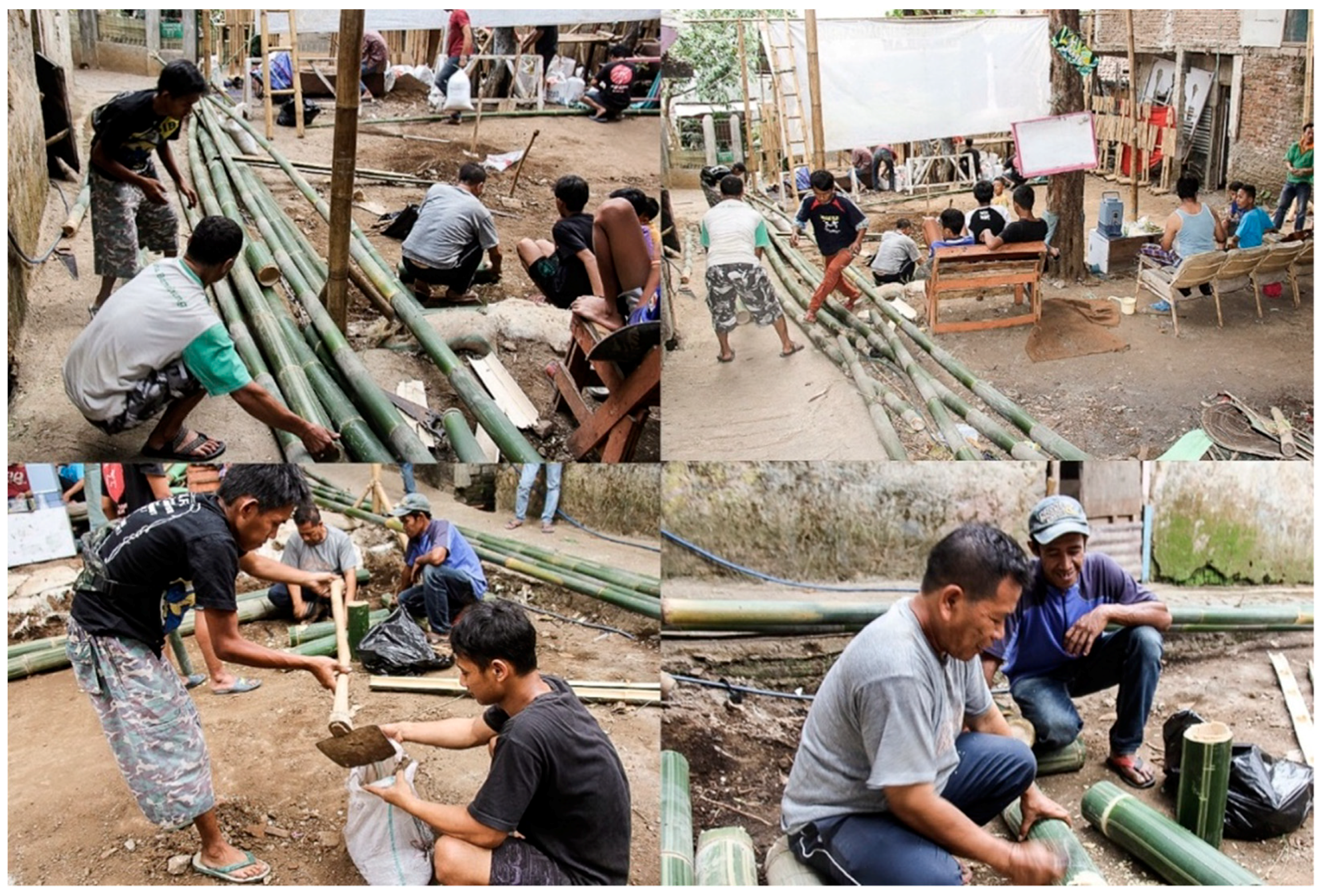
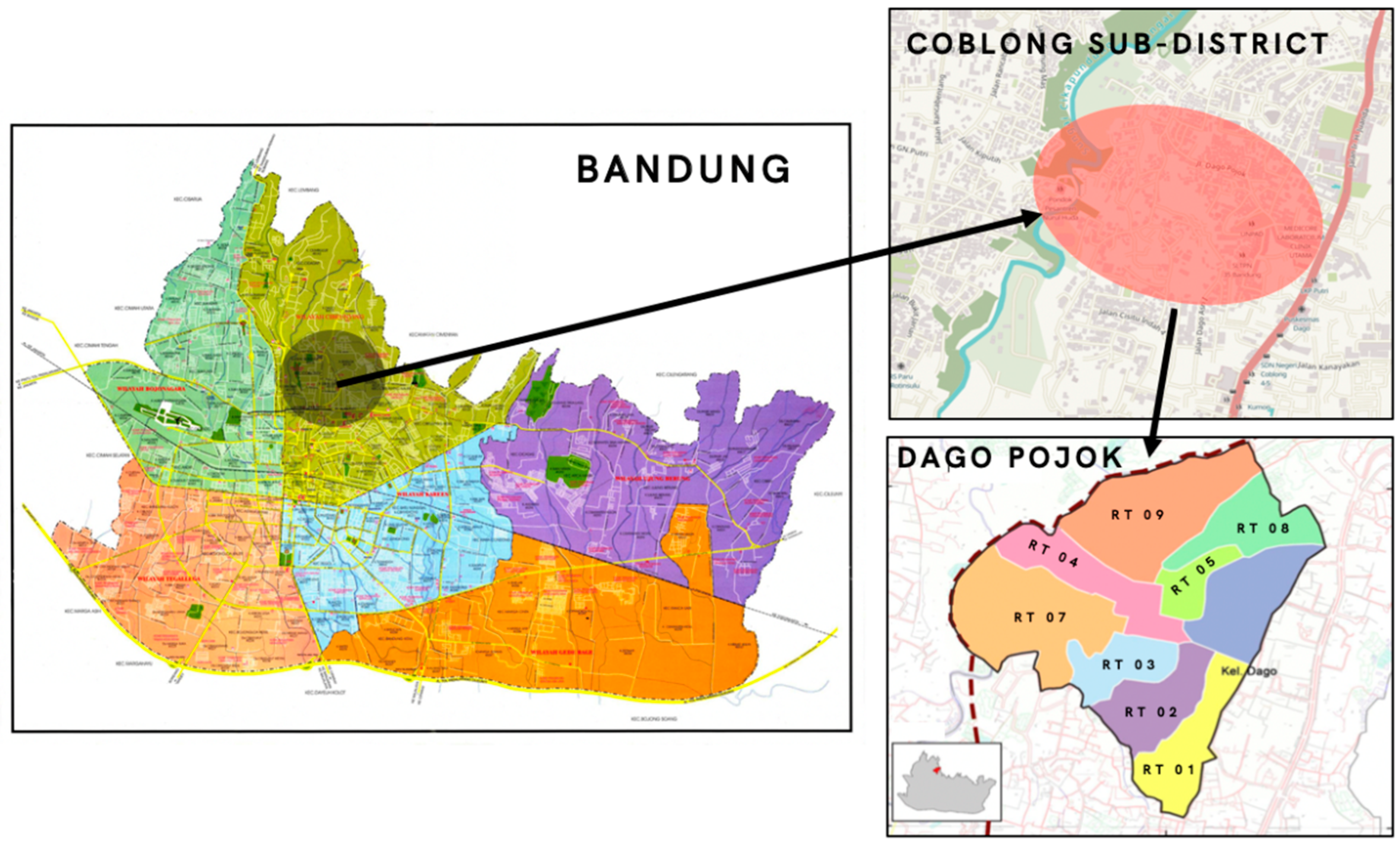
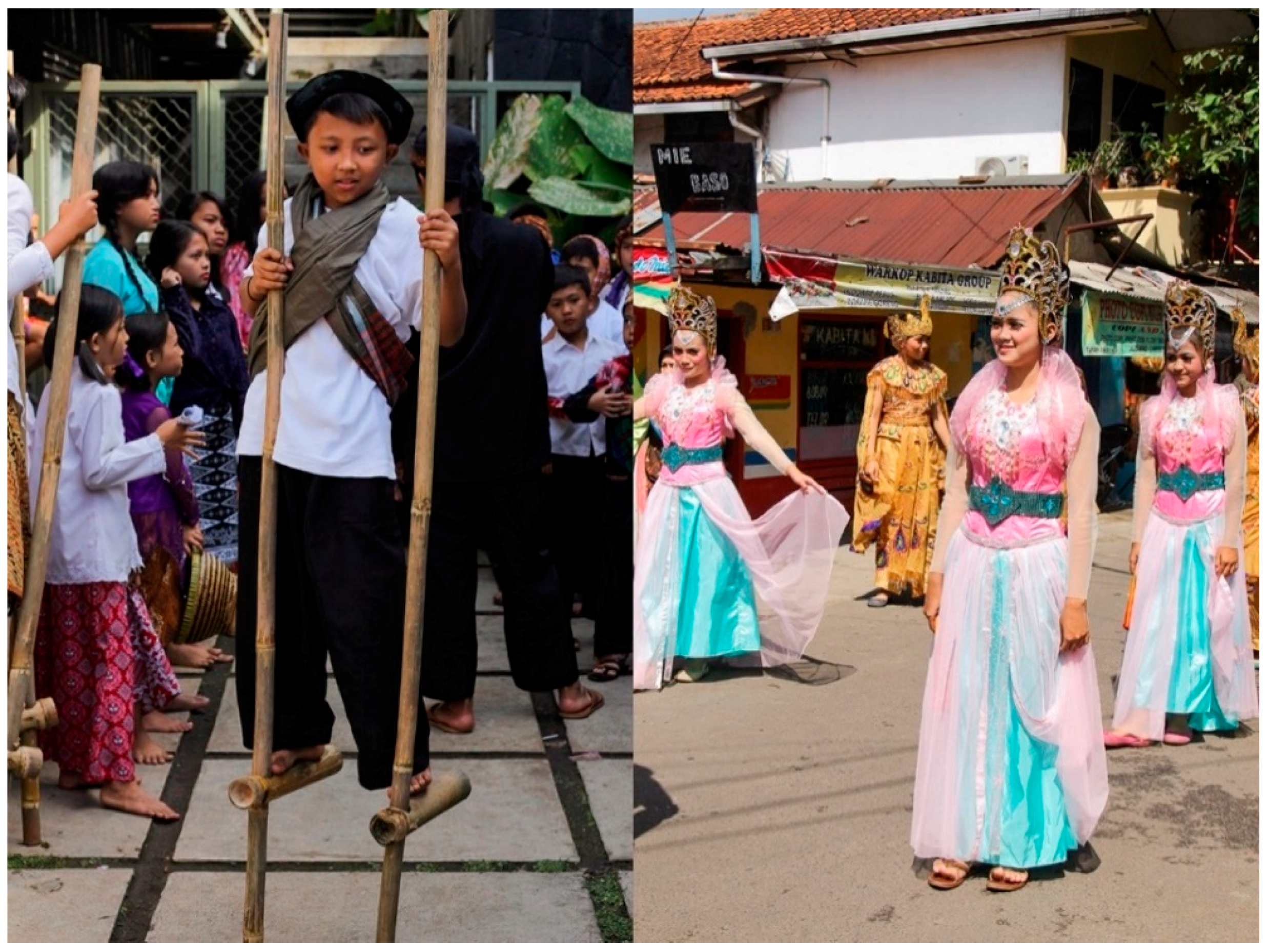
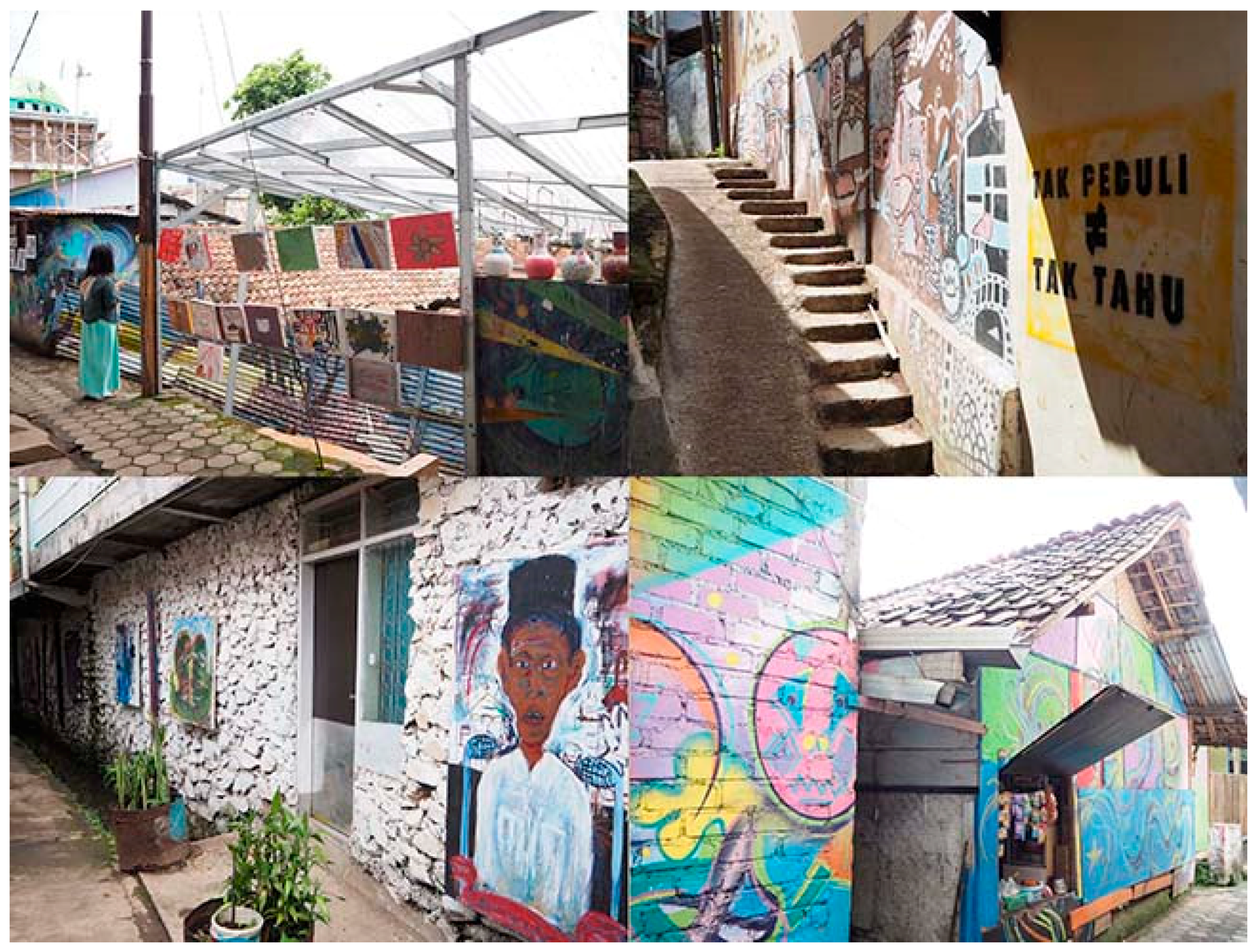
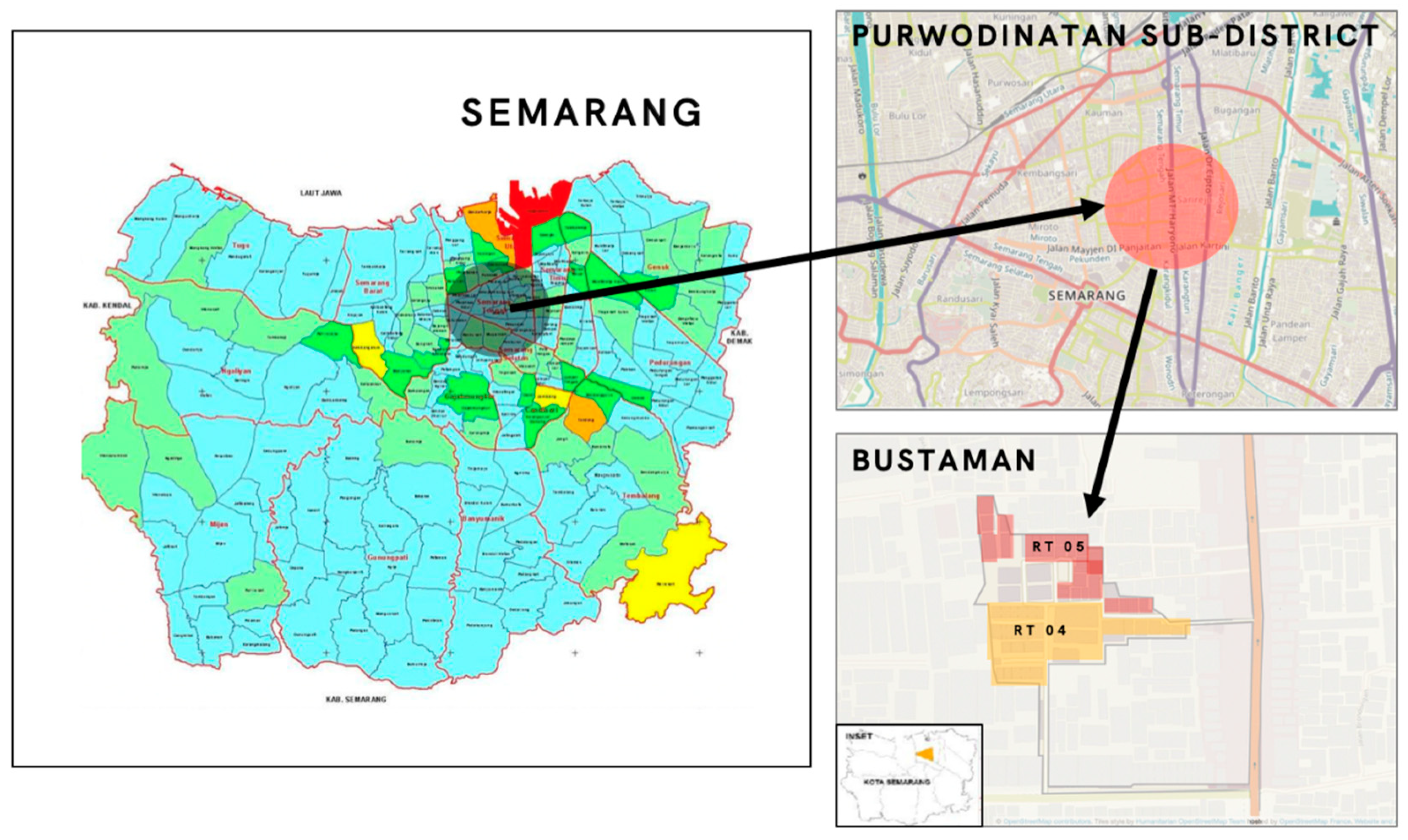
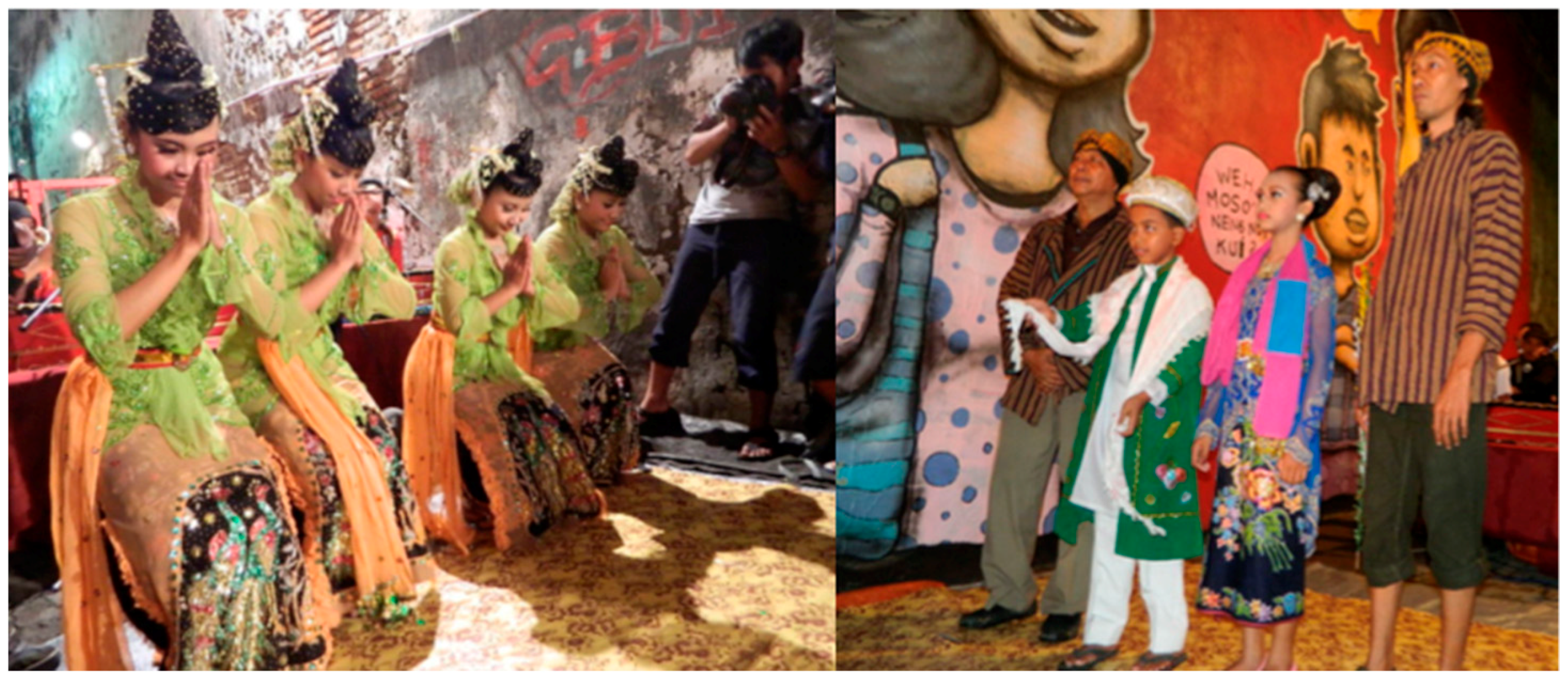
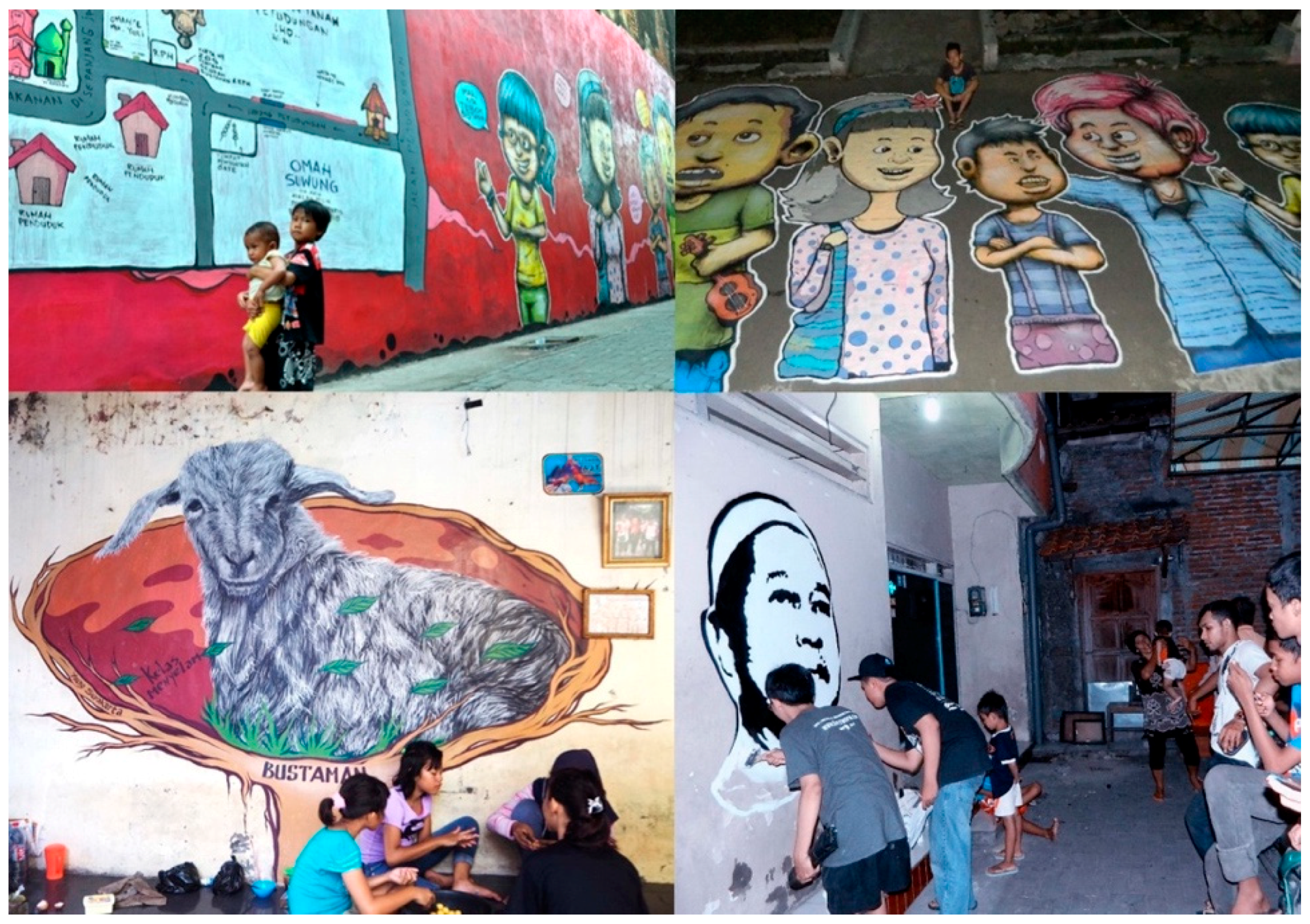
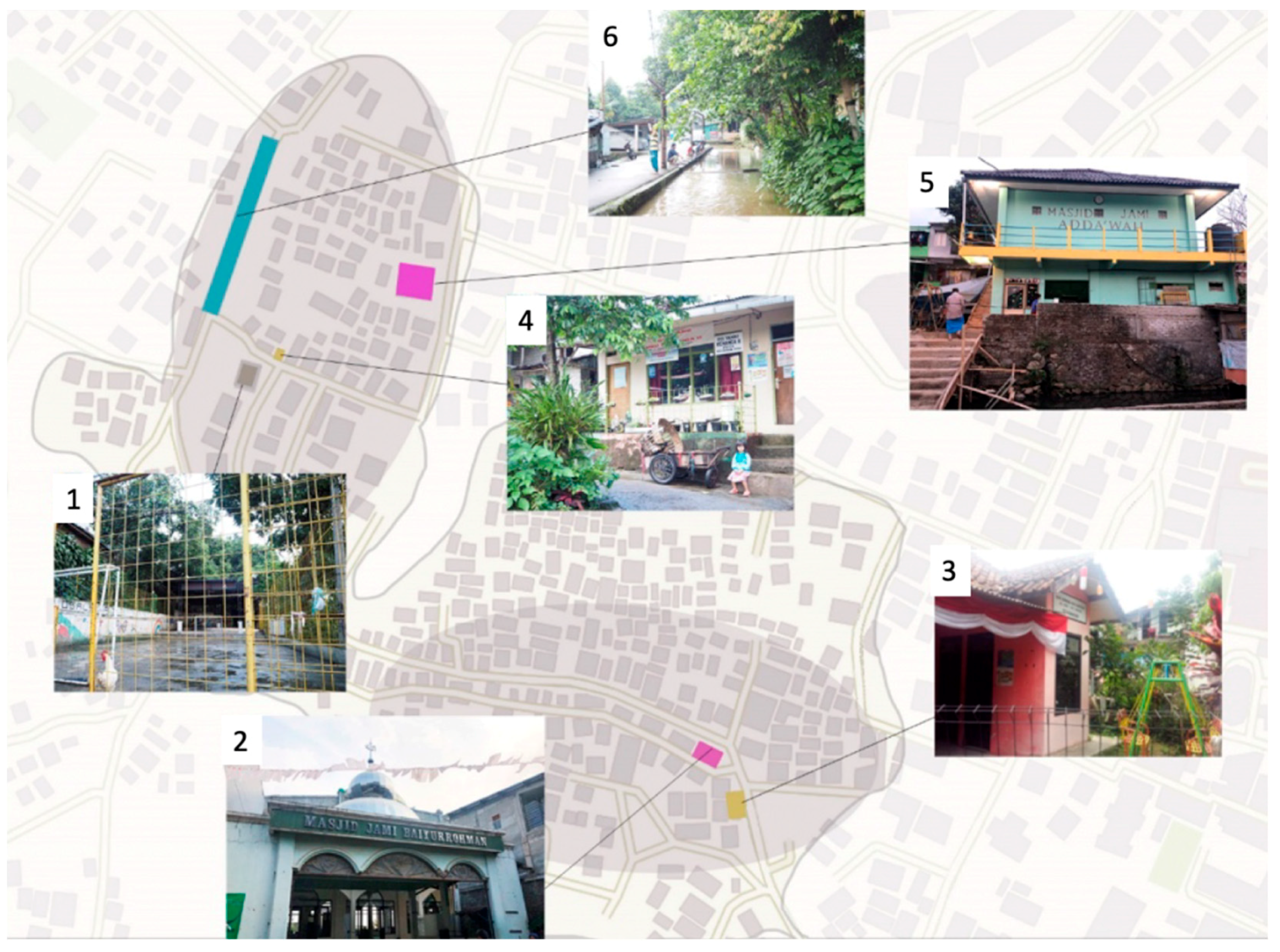
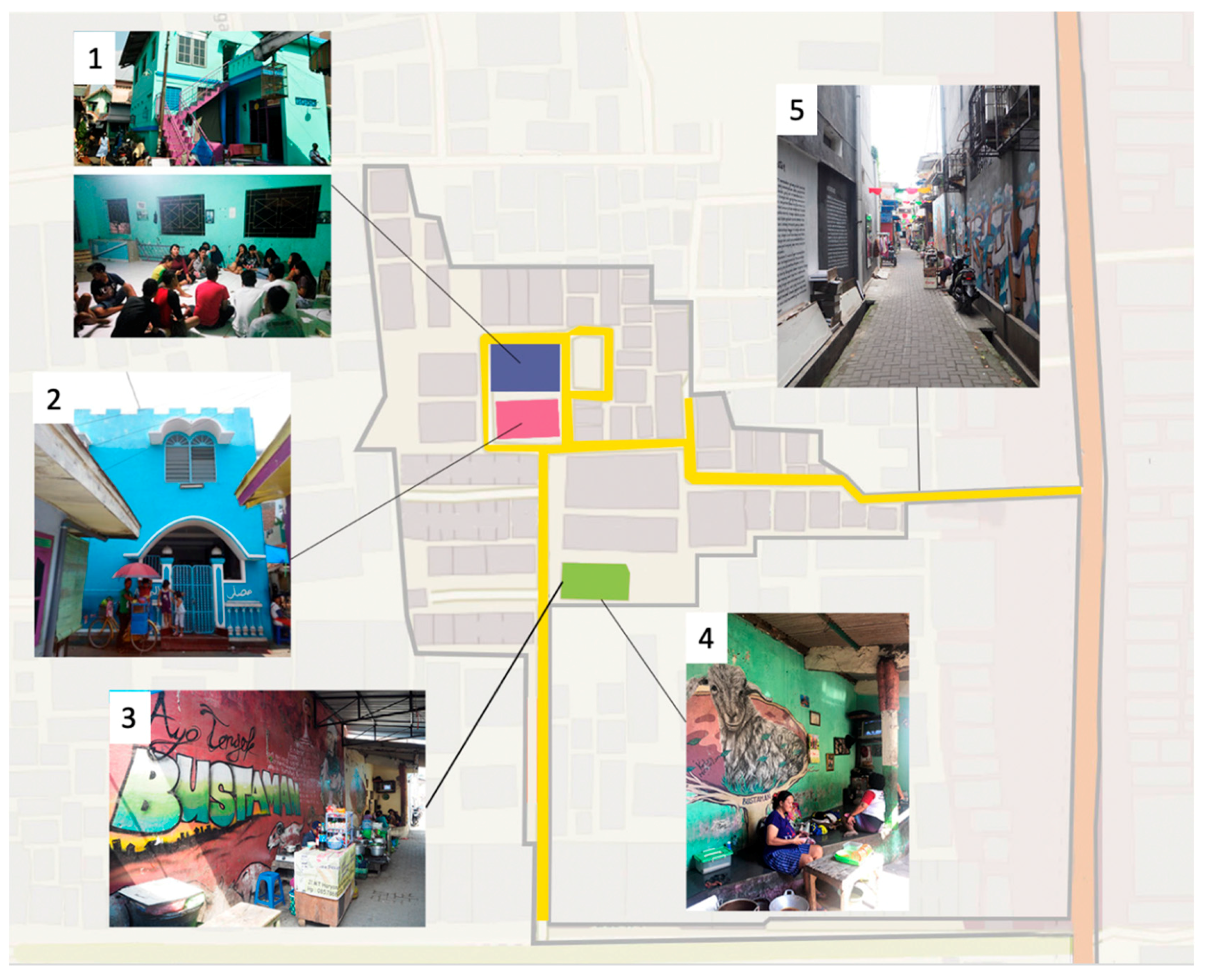
| Characteristics | Regular | Temporal |
|---|---|---|
| Frequency | Daily, weekly, monthly, occasionally | Annual, biannual |
| Scale | Individual, group, community, block, neighborhood level | Neighborhood or block level |
| Facilitation | Mostly by residents | Mostly facilitated by external stakeholders |
| Involved actors | Local residents (individual and neighborhood organizations), government, other external stakeholders | Local residents, civil society organization, government, other external stakeholders |
| Nature of Activity (based on the survey result) | Promoting wellbeing, establishing infrastructure, caring for public spaces, promoting social cohesion, and empowering women. | Promoting art and culture, social cohesion, recreational activities, and supporting young people |
| Type of Social Space in Kampungs | Characteristics |
|---|---|
| Streets/alleys/pathways | In a typical urban kampung, streets are directly connected with the house terrace and benches. It is on the streets that kampung dwellers usually spend much time to socialize with each other |
| Warung (small shop) | The presence of a small shop in kampungs shows the informality in the economic aspect. It not only functions as the supplier for affordable services to meet the daily basic needs of residents but also serves as a place to chat and hang out |
| Public bath and toilet | Public bath and toilet are also the places where residents interact at particular times of the day, such as when residents wait for their turn to take a bath and when women wash their clothes |
| Public facilities | Community hall, guard post, mosque, and Posyandu (neighborhood health clinic) are the common type of public facilities in kampungs. Other than their real functions (for instance, the mosque is used for praying), public facilities in kampungs play important roles in accommodating social interaction for dwellers who use the facilities |
| Open space | The form of open space is varied in every kampung. It can be a field, small gardens, left-over spaces between houses, or a vacant space for conducting various social activity |
| Typology | Location | Density | Settlement Characteristics |
|---|---|---|---|
| Inner-city kampung | Between the original colonial city and the new inland cores | High (100,000 people per square kilometer) | Share space in traditional house |
| Mid-city kampung | In the middle of a city | Medium (Between 20,000 and 40,000 people per square kilometer) | Two story of a concrete structured house |
| Peripheral kampung | Far from a city | Low | Traditional house |
| Temporary squatter kampung | Scattered in metropolitan area | - | Temporary house |
| Kampung | City | Total Population (Kampung) | Total Area (Ha) | Number of Households |
|---|---|---|---|---|
| Dago Pojok | Bandung | 3.852 1 | 258 2 | 1.035 |
| Bustaman | Semarang | 400 3 | 0.6 4 | 101 |
| Kampung | RT | Number of Households | Proportionate Sample Selection 1 |
|---|---|---|---|
| Dago Pojok | 1 | 148 | 24 |
| 2 | 174 | 28 | |
| 3 | 255 | 41 | |
| 4 | 183 | 30 | |
| 7 | 170 | 27 | |
| 9 | 105 | 17 | |
| Total | 1035 | 169 | |
| Bustaman | 4 | 50 | 33 |
| 5 | 51 | 34 | |
| Total | 101 | 67 | |
| Variables | Definition | Indicators | Unit of Measurement | Source | |
|---|---|---|---|---|---|
| Local empowerment | A process of change in which individuals or groups of local community, who initially has little or no control, have gained more power and capacity to intervene in particular things that affect their lives. | Knowledge exchange | Gain knowledge related to related to place-making activity | Likert statement | Peng (2013); Stewart (2010) |
| Gain knowledge related to kampung | |||||
| Gain knowledge related to general issue | |||||
| Capacity to intervene and be active in solving problems | Intervention in problem solving | ||||
| Involvement in volunteering | |||||
| Social connection | An improvement of connection within a community and among group of communities. | Diverse social groups in the community work together | Increases on the interaction, dialogue and cooperation among different hierarchical group of local residents | Likert statement | Delconte et al. (2016); Peng (2013) |
| Improve the relationship between long-standing and new comers | |||||
| Opportunities to meet new people | Expand social circle | ||||
| Attract various people from broader are of the city | |||||
| Mutual helps based on collaboration | Common objective among residents have drawn closer connection | ||||
| Quality of life | The characteristics of particular geographical area that can offer to its residents as well as the characteristics and wellbeing of the residents themselves. | Quality of place | Upgrading image from initial poor image to become good place | Likert statement | Cohen et al. (2018); Hunter (2012) |
| Vibrancy and Liveability | Add more activity to the area and make this kampong become more alive | ||||
| Safety and security | Walking at night is as safe as walking in the daylight | ||||
| Wellbeing | Residents enjoy better health outcomes in general, as a result of an improvement on the environment quality | ||||
| Local identity and pride | The specific social, cultural, and physical components of place that can contribute to strengthening the identity of the place and its inhabitants. | Confidence on individual and communal identity | Improvement in general local attitudes towards local culture and communal identity | Likert statement | Delconte et al. (2016); Hunter (2012); Main and Sandoval (2015); Rota and Salone (2014) |
| Cultural regeneration | Improvement to preserve and participate in cultural activities | ||||
| Local products and traditional events become more known to public | |||||
| Dependent Variables | Questionnaire Items | Cronbach’s Alpha |
|---|---|---|
| DV 1: LOCAL IDENTITY AND PRIDE | Improvement in general local attitudes towards local culture and identity | 0.829 |
| Improvement in general local attitudes towards cultural activities | ||
| Local specialties become more known to public | ||
| DV 2: LOCAL EMPOWERMENT | Higher opportunities to exchange knowledge related to the place-making practices in kampung | 0.853 |
| Higher opportunities to understand broader issues about kampung | ||
| Higher opportunities to gain general knowledge | ||
| General improvement among residents to intervene and be more active in solving problems | ||
| General improvement among residents to participate in voluntary works (including activities by non-profit organisation) | ||
| DV 3: SOCIAL CONNECTION | Improve the relationship between local people with different age | 0.812 |
| Improve the relationship between local people with different hierarchy (ethnics, jobs, incomes, political views) | ||
| Improve the relationship between long-standing with new-comers | ||
| Drawn closer connection among residents | ||
| Expand social circle of residents | ||
| Attract various people from broader area of the city | ||
| DV 4: QUALITY OF LIFE | Add more activity to and make kampung become more alive | 0.749 |
| Upgrading image of kampung | ||
| Improvement in safety and security | ||
| Residents enjoy better health outcomes in addition to an improvement on the environment quality |
| Independent Variables | B | β | t-Value | P | Tol. | VIF |
|---|---|---|---|---|---|---|
| DV1: Local pride and identity | ||||||
| Constant | 4.198 | 34.347 | 0.000 *** | |||
| Age | −0.086 | −0.180 | −2.983 | 0.003 ** | 0.960 | 1.042 |
| Temporal Place-making | 0.330 | 0.497 | 5.783 | 0.000 *** | 0.471 | 2.121 |
| Regular Place-making | 0.109 | 0.164 | 2.606 | 0.010 * | 0.883 | 1.133 |
| Regression equation: Local pride and identity = 4.198 + 0.330 (Temporal Place-making) + 0.109 (Regular Place-making) | ||||||
| R2 = 0.228, F (4, 222) = 16.395, (p = 0.000) *** | ||||||
| DV2: Empowerment | ||||||
| Constant | 3.820 | 23.428 | 0.000 *** | |||
| Age | −0.080 | −0.162 | −2.922 | 0.004 ** | 0.938 | 1.066 |
| Income | 0.048 | 0.120 | 2.155 | 0.032 * | 0.926 | 1.080 |
| Temporal Place-making | 0.363 | 0.530 | 6.712 | 0.000 *** | 0.463 | 2.161 |
| Regular Place-making | 0.179 | 0.261 | 4.570 | 0.000 *** | 0.882 | 1.134 |
| Regression equation: Empowerment = 3.820 + 0.363 (Temporal Place-making) + 0.179 (Regular Place-making) | ||||||
| R2 = 0.363, F (5, 221) = 25.172, (p = 0.000) *** | ||||||
| DV3: Social connection | ||||||
| Constant | 3.908 | 26.895 | 0.000 *** | |||
| Age | −0.086 | −0.215 | −3.416 | 0.001 *** | 0.948 | 1.055 |
| Income | 0.044 | 0.137 | 2.202 | 0.029 * | 0.968 | 1.033 |
| Regular Place-making | 0.140 | 0.251 | 4.080 | 0.000 *** | 0.992 | 1.008 |
| Temporal Place-making | 0.091 | 0.163 | 2.641 | 0.009 * | 0.984 | 1.016 |
| Regression equation: Social connection = 3.908 + 0.140 (Regular Place-making) + 0.091 (Temporal Place-making) | ||||||
| R2 = 0.167, F (4, 222) = 11.158, (p = 0.000) *** | ||||||
| DV4: Quality of life | ||||||
| Constant | 3.850 | 28.012 | 0.000 *** | |||
| Age | −0.057 | −0.155 | −2.407 | 0.017 * | 0.964 | 1.038 |
| Income | 0.056 | 0.189 | 2.943 | 0.004 * | 0.968 | 1.033 |
| Regular Place-making | 0.111 | 0.216 | 3.405 | 0.001 *** | 0.992 | 1.008 |
| Regression equation: Quality of life = 3.850 + 0.111 (Regular Place-making) | ||||||
| R2 = 0.114, F (3, 223) = 9.532, (p = 0.000) *** | ||||||
© 2020 by the authors. Licensee MDPI, Basel, Switzerland. This article is an open access article distributed under the terms and conditions of the Creative Commons Attribution (CC BY) license (http://creativecommons.org/licenses/by/4.0/).
Share and Cite
Akbar, P.N.G.; Edelenbos, J. Social Impacts of Place-Making in Urban Informal Settlements: A Case Study of Indonesian Kampungs. Soc. Sci. 2020, 9, 104. https://doi.org/10.3390/socsci9060104
Akbar PNG, Edelenbos J. Social Impacts of Place-Making in Urban Informal Settlements: A Case Study of Indonesian Kampungs. Social Sciences. 2020; 9(6):104. https://doi.org/10.3390/socsci9060104
Chicago/Turabian StyleAkbar, Poeti Nazura Gulfira, and Jurian Edelenbos. 2020. "Social Impacts of Place-Making in Urban Informal Settlements: A Case Study of Indonesian Kampungs" Social Sciences 9, no. 6: 104. https://doi.org/10.3390/socsci9060104
APA StyleAkbar, P. N. G., & Edelenbos, J. (2020). Social Impacts of Place-Making in Urban Informal Settlements: A Case Study of Indonesian Kampungs. Social Sciences, 9(6), 104. https://doi.org/10.3390/socsci9060104






